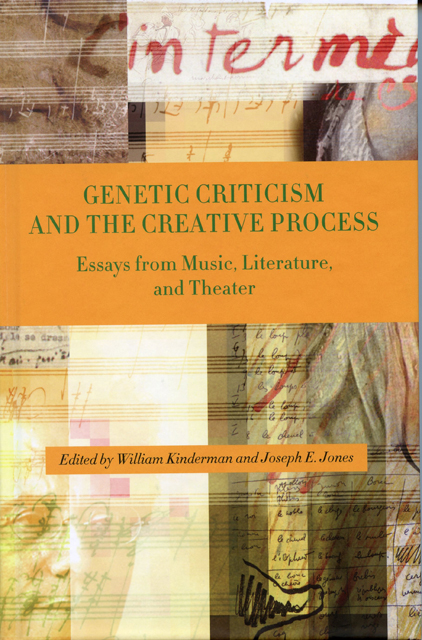Book contents
- Frontmatter
- Contents
- Acknowledgments
- Genetic Criticism and the Creative Process
- 1 Texts, Variants, and Variations: Evolving Contexts in Literature and Theater
- 2 Genetic Processes in Music: From Beethoven to Leroux
- 1 From Varieties of Genetic Experience to Radical Philology
- 2 Variant and Variation: Toward a Freudo-bathmologico-Bakhtino-Goodmanian Genetic Model?
- 3 The Genetic Record of a Voice: Variants in Barthes's Le Plaisir du texte
- 4 Can Genetic Criticism Be Applied to the Performing Arts?
- 5 “The hardy Laurel”: Beckett and Early Film Comedy
- 6 From Melodic Patterns to Themes: The Sketches for the Original Version of Beethoven's “Waldstein” Sonata, Op. 53
- 7 From Conceptual Image to Realization: Some Thoughts on Beethoven's Sketches
- 8 The Process within the Product: Exploratory Transitional Passages in Beethoven's Late Quartet Sketches
- 9 “They Only Give Rise to Misunderstandings”: Mahler's Sketches in Context
- 10 A Study of Richard Strauss's Creative Process: Der Rosenkavalier's “Presentation Scene” and “Schlußduett”
- 11 Genetic Criticism and Cognitive Anthropology: A Reconstruction of Philippe Leroux's Compositional Process for Voi(rex)
- Afterword
- Contributors
- Index
10 - A Study of Richard Strauss's Creative Process: Der Rosenkavalier's “Presentation Scene” and “Schlußduett”
Published online by Cambridge University Press: 02 March 2023
- Frontmatter
- Contents
- Acknowledgments
- Genetic Criticism and the Creative Process
- 1 Texts, Variants, and Variations: Evolving Contexts in Literature and Theater
- 2 Genetic Processes in Music: From Beethoven to Leroux
- 1 From Varieties of Genetic Experience to Radical Philology
- 2 Variant and Variation: Toward a Freudo-bathmologico-Bakhtino-Goodmanian Genetic Model?
- 3 The Genetic Record of a Voice: Variants in Barthes's Le Plaisir du texte
- 4 Can Genetic Criticism Be Applied to the Performing Arts?
- 5 “The hardy Laurel”: Beckett and Early Film Comedy
- 6 From Melodic Patterns to Themes: The Sketches for the Original Version of Beethoven's “Waldstein” Sonata, Op. 53
- 7 From Conceptual Image to Realization: Some Thoughts on Beethoven's Sketches
- 8 The Process within the Product: Exploratory Transitional Passages in Beethoven's Late Quartet Sketches
- 9 “They Only Give Rise to Misunderstandings”: Mahler's Sketches in Context
- 10 A Study of Richard Strauss's Creative Process: Der Rosenkavalier's “Presentation Scene” and “Schlußduett”
- 11 Genetic Criticism and Cognitive Anthropology: A Reconstruction of Philippe Leroux's Compositional Process for Voi(rex)
- Afterword
- Contributors
- Index
Summary
Addressing two significant lacunae in the critical scholarship concerned with Der Rosenkavalier promises insight into Strauss's evolving conception of the opera and some of the aesthetic strategies that impacted its completed form. A substantially undervalued area for investigation involves the earliest extant compositional manuscripts, which reveal, above all, Strauss making harmonic choices that would shape the dramatic action of the opera. Although the musical thematic content of Der Rosenkavalier has been explored in depth,1 thorough analysis of the opera's large-scale tonal planning has yet to be pursued. The following study undertakes such analysis in the process of reevaluating the opera's conclusion, how the final duet of Octavian and Sophie refl ects upon their first meeting and how it illuminates underlying aesthetic premises of the opera as a whole. The moment when Sophie drops her handkerchief in the opera's final measures has been interpreted as a sign that she is already open to infidelities at the very onset of her relationship with Octavian, a gesture that renders ambiguous much that has happened in the drama. As I will show, Strauss's handling of the first encounter of the young lovers—the so-called presentation scene—as traced from his earliest sketches to the finished score bears significant implications for interpreting the work's conclusion.
Context
In her memoir Singing with Richard Strauss, Lotte Lehmann describes the presentation scene in Act II of Der Rosenkavalier: “Musically the arrival of Octavian is framed in the sort of glamour that only Richard Strauss was able to create; the truly magnificent duet between Sophie and Octavian contains all the splendour of youth and all the beauty embodied in these two human beings. inevitable happens, as it must—Octavian immediately and desperately falls in love with the girl.”2 Her account of this beloved operatic moment reveals the essence of what attracts many to the opera. Norman Del Mar contends that the “translucent orchestral colouring and beauty of imagination make it one of the most magical passages in the whole of Strauss's output.”3 Yet this scene in which Octavian presents Sophie with Ochs's silver rose has also been a target for criticism.
- Type
- Chapter
- Information
- Genetic Criticism and the Creative ProcessEssays from Music, Literature, and Theater, pp. 170 - 191Publisher: Boydell & BrewerPrint publication year: 2009



